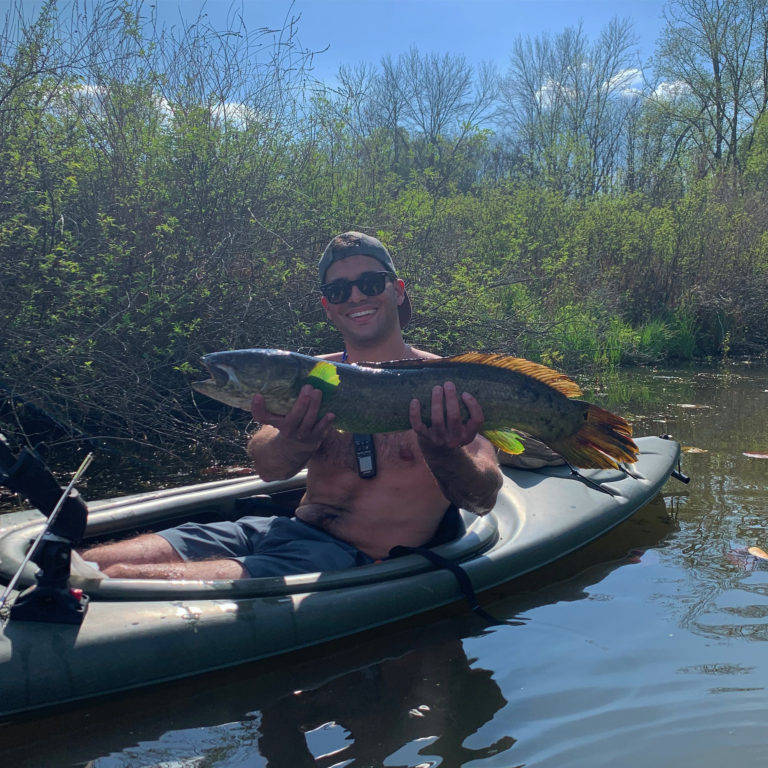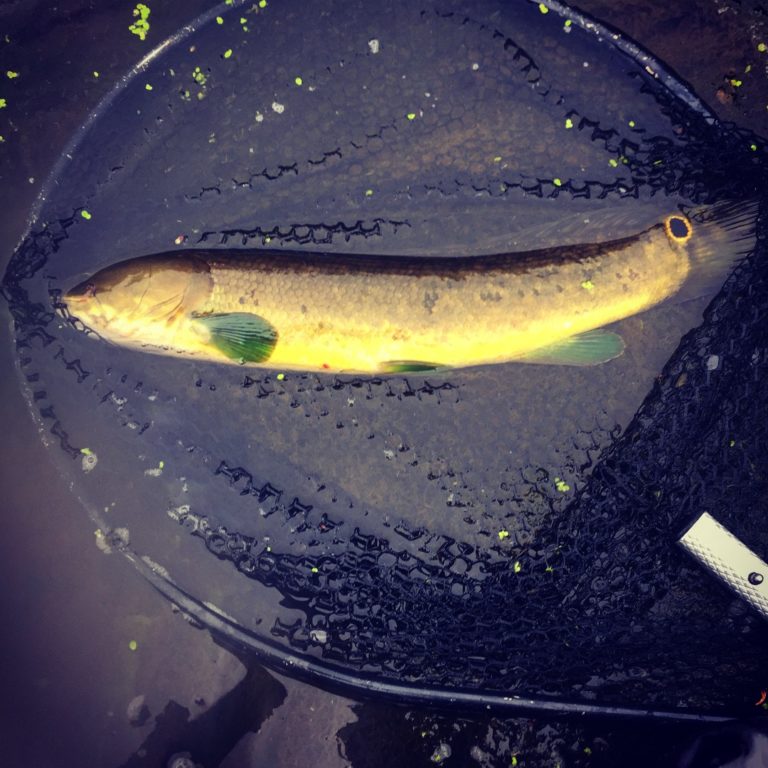The Bowfin

The bowfin (Amia calva) is a very unique fish found in some areas of western New York. Bowfin typically range between 18 and 24 inches in length and can be identified by their very long dorsal fin, round tail, wide, bony heads, pointy teeth, and characteristic eyespot on the upper part of the base of their tail. During spawning season, male bowfin can develop a beautiful bright green color on their bellies, fins, and sometimes mouths.
Bowfin are beautiful, predatory fish native to western New York that should be admired and respected. Bowfin are a natural part of numerous ecosystems here in western New York and contrary to the belief of many, do NOT damage sport fish populations. Bowfin have been here long before us and will likely be here long after us. Bowfin, like longnose gar, have retained the morphological features of their ancestors that date back over 100 million years. Bowfin, like longnose gar, are living fossils and offer us a rare glimpse into what wildlife looked like in times long since passed.
Bowfin are often the victims of misidentification. The body structure of a bowfin somewhat resembles that of a catfish; however, bowfin lack the barbels (whiskers) present on catfish. More unfortunately, bowfin are often misidentified as the invasive and highly destructive northern snakehead. Therefore, bowfin are sometimes killed by those who mistake them for an invasive species.
Fortunately, bowfin are very easy to distinguish from the northern snakehead. Bowfin do NOT have a long anal fin (the fin on their belly closest to their tail). The anal fin of the bowfin is about the same width as its pectoral fins. The northern snakehead, on the other hand, has a very long anal fin that stretches from the middle of its belly all the way to the base of its tail. As of 2017, snakehead have not been documented in western New York.
Habitat
Bowfin primarily inhabit large, sluggish, creeks and rivers. Bowfin can probably be found in lakes as well. In creeks and rivers, bowfin prefer sluggish areas or backwater with plenty of weeds. Bowfin probably lurk in the weeds because they offer good cover and plenty of baitfish to hunt.
Like longnose gar, bowfin are adept to survive in even the harshest of environments and can survive in warm water that is devoid of oxygen. Bowfin are able to survive in oxygen deprived environments by using their modified swim bladder to breathe air from the surface.
Food
Bowfin are predatory fish and feed on both other fish and crustaceans. Though they will scavenge in a similar manner to catfish, they will also ambush and attack prey opportunistically. Contrary to the belief of many, bowfin do NOT damage sport fish populations. What does damage sport fish populations is keeping every fish you catch or mishandling the ones you plan on releasing
Where to Catch Bowfin
Bowfin can be found in some creeks and rivers in western New York. Good places to find bowfin are the large, sluggish tributaries of Lake Erie (north of Buffalo) and Lake Ontario as well as the upper Niagara River. The best Lake Erie tributary to find bowfin is probably Tonawanda Creek, especially the lower section. On Lake Ontario, bowfin can be found in18 Mile Creek and in the sluggish portion of The Oak Orchard River. The Oak Orchard River is probably the best place in western New York to catch bowfin.
Both the lower and upper sections of the Niagara River also hold bowfin. Tributaries that drain into the Niagara River from Erie and Niagara counties can also provide good fishing for bowfin, especially in and around Grand Island. Bowfin populations generally increase from northern Erie County northeastward toward Lake Ontario and the St. Lawrence River.

How to Catch Bowfin
Bowfin can be caught on a variety of baits, both natural and artificial. Good natural baits include minnows, chubs, suckers, and probably crayfish. Bowfin can also be caught on cut bait. Minnows or cut bait can be fished either under a float or on the bottom. A good bottom rig is cut bait on an octopus or circle hook with a large weight added 1-2 feet above the hook. When fishing bottom rigs, enough weight should be added so your line doesn’t drift in the current. When fishing minnows or cut bait under a float, try set your depth so the bait drifts close to the bottom.
Bowfin can also be caught on a variety of artificial lures. Bowfin are aggressive predators and won’t hesitate to attack lures such as inline spinners, spinnerbaits, or stick baits. Bowfin can also be caught on soft plastics including soft plastic worms, crayfish, and minnows (the bowfin pictured at the beginning of this article was caught on a Berkley Gulp worm). When targeting bowfin, work weedy shallows in slow moving water.
